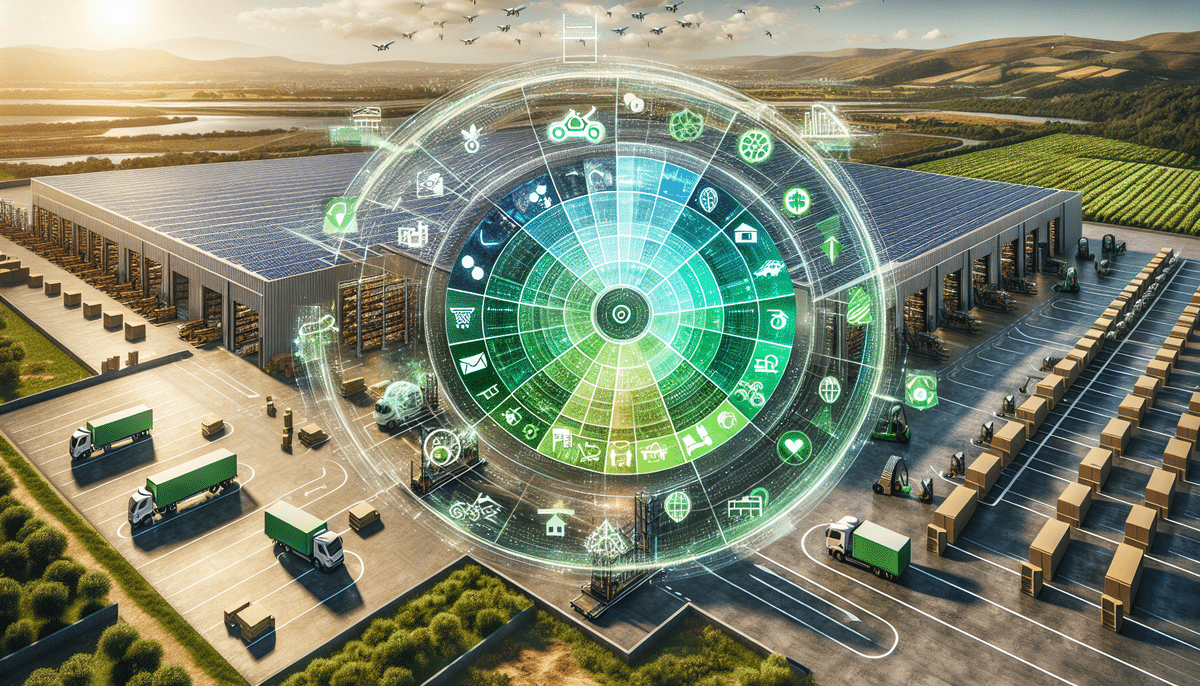Unlocking the Potential of the Fulfillment Innovation Wheel for Sustainable Fulfillment
In today's rapidly evolving business landscape, sustainability has become a top priority for many companies. Sustainable fulfillment is not only about reducing carbon emissions and waste, but also about building a supply chain that benefits both the environment and society while delivering an exceptional customer experience. The Fulfillment Innovation Wheel is a powerful tool that helps companies optimize their fulfillment strategy for sustainability, customer satisfaction, and cost-effectiveness.
Understanding the Fulfillment Innovation Wheel: A Comprehensive Overview
The Fulfillment Innovation Wheel is a process that enables companies to analyze their fulfillment strategy across nine stages:
- Sourcing
- Planning
- Order Management
- Inventory Management
- Procurement
- Inbound Logistics
- Warehousing
- Outbound Logistics
- Customer Delivery
This framework provides a structure for businesses to optimize their fulfillment operations and create a more sustainable supply chain. The interlinked nature of these stages involves both internal and external processes that affect the entire fulfillment chain.
One of the key benefits of using the Fulfillment Innovation Wheel is the ability to identify areas where businesses can improve efficiency and reduce costs. For example, analyzing inventory management processes can help companies identify slow-moving products and adjust ordering patterns to reduce waste. Similarly, optimizing inbound logistics can lower transportation costs and improve delivery times. By leveraging the Fulfillment Innovation Wheel, companies can create a streamlined and cost-effective fulfillment process that benefits both the business and its customers.
The Importance of Sustainable Fulfillment in Today's Business Landscape
The benefits of sustainable fulfillment are far-reaching, including environmental conservation, social responsibility, cost reduction, and increased customer satisfaction. Adopting sustainable practices is essential not only to meet regulatory requirements but also to protect brand image and reputation. Implementing the Fulfillment Innovation Wheel enables companies to achieve an optimal balance between costs, customer satisfaction, and sustainability.
Key aspects of sustainable fulfillment include:
- Reducing waste through eco-friendly packaging materials
- Optimizing transportation routes
- Implementing recycling programs
By reducing waste, businesses can minimize their environmental impact and save costs in the long run. Additionally, consumers are increasingly conscious of the environmental impact of their purchases and are more likely to support businesses that prioritize sustainability. Therefore, sustainable fulfillment not only benefits the planet but also enhances the bottom line and fosters customer loyalty.
Exploring the Different Stages of the Fulfillment Innovation Wheel
Each stage of the Fulfillment Innovation Wheel plays a crucial role in achieving sustainable fulfillment:
- Sourcing: Identifying and selecting suppliers committed to sustainability.
- Planning: Developing strategies to meet customer demand while minimizing waste and reducing carbon emissions.
- Order Management: Ensuring accurate order fulfillment and efficient inventory management to reduce waste.
- Procurement: Sourcing sustainable, eco-friendly materials.
- Inbound Logistics: Receiving materials at the right time and place to reduce greenhouse gas emissions.
- Warehousing: Reducing energy consumption and waste within storage facilities.
- Outbound Logistics: Optimizing delivery routes to lower carbon emissions.
- Customer Delivery: Utilizing sustainable delivery options to provide a positive customer experience.
- Product Design: Designing products with sustainability in mind to minimize environmental impact.
- Post-Sales Support: Offering repair, maintenance, and recycling services to extend product life and reduce waste.
By thoroughly addressing each stage, companies can significantly reduce their environmental footprint and enhance overall sustainability.
How to Optimize Your Fulfillment Strategy Using the Innovation Wheel
The first step to optimizing your fulfillment strategy with the Fulfillment Innovation Wheel is to identify areas for improvement by analyzing existing fulfillment processes. This analysis can uncover inefficiencies, waste, and opportunities to enhance sustainability. Once these areas are identified, develop a strategy that incorporates sustainable practices, reduces waste and greenhouse gas emissions, and improves customer satisfaction.
The Fulfillment Innovation Wheel offers a structured approach to implementing your strategy across all nine stages of the fulfillment process. Key steps include:
- Identify Areas for Improvement: Conduct a comprehensive analysis of current processes.
- Develop Sustainable Strategies: Incorporate practices that reduce waste and emissions.
- Implement Changes: Apply the strategies across all fulfillment stages.
- Regularly Review and Update: Continuously assess and refine processes to stay effective.
- Involve Your Team: Engage team members to gather feedback and foster a culture of sustainability.
Regularly reviewing and updating processes ensures that your fulfillment strategy remains effective as your business grows and evolves. Involving your team in the optimization process can lead to new ideas and greater investment in the strategy's success.
The Role of Technology in Sustainable Fulfillment: A Guide to Best Practices
Technology plays a vital role in sustainable fulfillment by enabling automation, reducing waste, and optimizing costs. Key technological advancements include:
- Artificial Intelligence and Advanced Analytics: Facilitate data-driven decisions to enhance sustainability.
- Data Management Platforms: Support real-time inventory management and order tracking.
- Cloud Platforms: Reduce IT infrastructure costs and improve operational efficiency.
- Drone Deliveries and Electric Vehicles: Lower greenhouse gas emissions and make deliveries more sustainable.
In addition to these technologies, businesses can implement sustainable packaging solutions, such as using biodegradable or compostable materials, reducing packaging size and weight, and adopting reusable packaging options. These practices help reduce waste and improve overall sustainability efforts.
Furthermore, incorporating sustainable practices throughout the supply chain—like sourcing materials from eco-friendly suppliers and minimizing transportation emissions—contributes to a more sustainable fulfillment process.
Overcoming Common Challenges in Implementing the Fulfillment Innovation Wheel
Implementing the Fulfillment Innovation Wheel can present several challenges, particularly for businesses with established fulfillment processes. Common obstacles include:
- Resistance to Change: Employees and stakeholders may be hesitant to adopt new practices.
- Lack of Data and Analytics: Insufficient data to measure the success of new processes.
To address resistance to change, businesses should communicate the benefits of sustainable fulfillment to all stakeholders and involve them in the implementation process. Training employees on new processes and technologies and fostering a culture that embraces sustainability are essential steps.
To overcome the lack of data and analytics, businesses must establish key performance indicators (KPIs) and regularly track and analyze data to identify areas for improvement. A data-driven approach allows for informed decision-making and continuous optimization of fulfillment processes for maximum efficiency and sustainability.
Measuring Success: Key Metrics for Evaluating Your Sustainable Fulfillment Strategy
Measuring the success of your sustainable fulfillment strategy is crucial for assessing progress and identifying areas for improvement. Key metrics to consider include:
- Carbon Emissions: Track the reduction in greenhouse gas emissions.
- Waste Reduction: Measure the decrease in waste generated.
- Customer Satisfaction: Assess customer feedback and satisfaction levels.
- Cost Savings: Calculate the financial savings achieved through sustainable practices.
Additionally, benchmarking against industry best practices can highlight opportunities for further improvement. Another important metric is employee engagement. Engaged employees are more likely to contribute to sustainability efforts and identify new improvement opportunities. Measuring employee engagement through surveys and feedback mechanisms can help improve communication and involvement within the workforce.
Evaluating the impact of your sustainable fulfillment strategy on the local community is also essential. Metrics may include job creation, economic development, and community engagement. Understanding these impacts can help businesses strengthen relationships with local stakeholders and contribute to the overall well-being of the community.
Case Studies: Companies that Have Successfully Implemented the Fulfillment Innovation Wheel
Several companies have successfully utilized the Fulfillment Innovation Wheel to achieve sustainable fulfillment:
- Amazon: Implemented eco-friendly packaging, renewable energy sources, and electric vehicles to reduce its carbon footprint.
- IKEA: Adopted sustainable sourcing practices, reduced plastic waste, and established energy-efficient warehousing and distribution centers.
- Patagonia: Embraced a circular economy model by encouraging product repair and reuse, offering trade-in programs, and utilizing renewable energy sources. Additionally, Patagonia has reduced water usage in production processes, enhancing both environmental impact and customer loyalty.
These companies demonstrate that sustainable fulfillment is not only feasible but also profitable, showcasing the positive impact of the Fulfillment Innovation Wheel.
Future Trends in Sustainable Fulfillment and the Role of the Innovation Wheel
The future of sustainable fulfillment is promising, with emerging technologies and practices aimed at reducing waste and supporting sustainability:
- Blockchain Technology: Enhances transparency and traceability in the supply chain.
- Circular Economy Principles: Focuses on reducing waste and ensuring efficient resource use.
- Renewable Energy and Carbon-Neutral Practices: Increasingly important for sustainable fulfillment operations.
- Advanced Packaging Solutions: Use of biodegradable, compostable, and reusable packaging materials.
- Automation and Robotics: Improve efficiency and reduce transportation and energy consumption in fulfillment centers.
The Fulfillment Innovation Wheel will continue to play a critical role in helping businesses integrate these trends and innovations, enabling them to stay competitive and meet the expectations of environmentally conscious consumers.
Conclusion
The Fulfillment Innovation Wheel is a powerful tool that enables businesses to achieve sustainable fulfillment while enhancing customer satisfaction and reducing costs. By optimizing all nine stages of the fulfillment process, businesses can create a more sustainable supply chain, reduce waste and greenhouse gas emissions, and achieve their sustainability goals. Although implementing the innovation wheel can be challenging, businesses that invest in the necessary resources, technology, and infrastructure will benefit from a more sustainable and profitable supply chain.






















